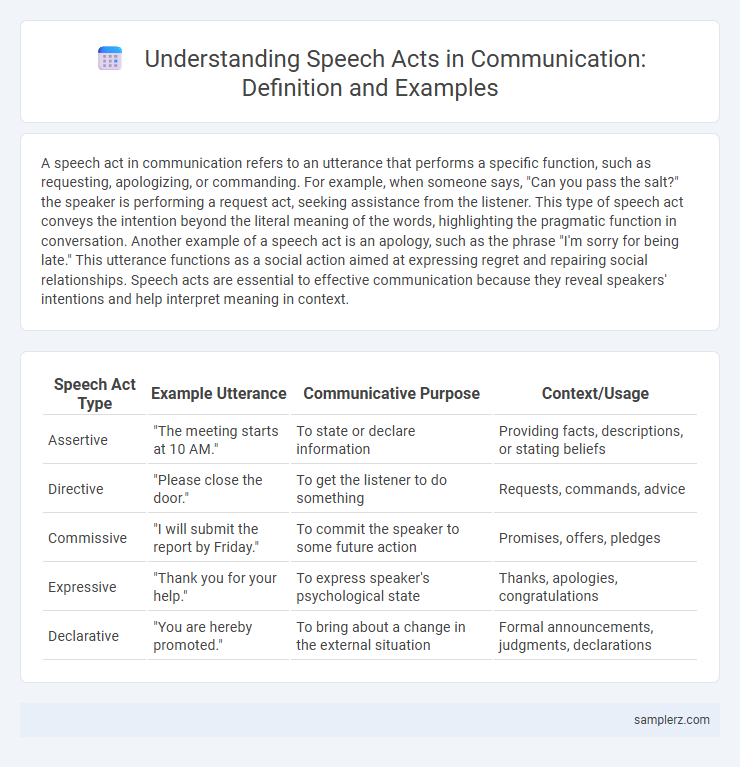A speech act in communication refers to an utterance that performs a specific function, such as requesting, apologizing, or commanding. For example, when someone says, "Can you pass the salt?" the speaker is performing a request act, seeking assistance from the listener. This type of speech act conveys the intention beyond the literal meaning of the words, highlighting the pragmatic function in conversation. Another example of a speech act is an apology, such as the phrase "I'm sorry for being late." This utterance functions as a social action aimed at expressing regret and repairing social relationships. Speech acts are essential to effective communication because they reveal speakers' intentions and help interpret meaning in context.
Table of Comparison
| Speech Act Type | Example Utterance | Communicative Purpose | Context/Usage |
|---|---|---|---|
| Assertive | "The meeting starts at 10 AM." | To state or declare information | Providing facts, descriptions, or stating beliefs |
| Directive | "Please close the door." | To get the listener to do something | Requests, commands, advice |
| Commissive | "I will submit the report by Friday." | To commit the speaker to some future action | Promises, offers, pledges |
| Expressive | "Thank you for your help." | To express speaker's psychological state | Thanks, apologies, congratulations |
| Declarative | "You are hereby promoted." | To bring about a change in the external situation | Formal announcements, judgments, declarations |
Introduction to Speech Acts in Communication
Speech acts in communication encompass actions like asserting, questioning, and requesting, which convey intentions beyond mere words. For example, when someone says, "Can you pass the salt?" it functions as a request rather than a question about ability. These speech acts demonstrate how utterances perform functions such as informing, commanding, or promising, shaping effective interpersonal interactions.
Types of Speech Acts with Real-Life Examples
Locutionary acts involve the actual utterance and its literal meaning, such as saying "It's raining" to describe weather conditions. Illocutionary acts convey the speaker's intention, like requesting with "Could you close the window?" or promising in "I will call you tomorrow." Perlocutionary acts produce an effect on the listener, for example, persuading someone to stay indoors by saying "It looks dangerous outside.
Assertive Speech Acts: Stating Facts and Opinions
Assertive speech acts convey information by stating facts or expressing opinions, thereby committing the speaker to the truth of the proposition. Examples include declarations like "The Earth revolves around the Sun" or subjective statements such as "I believe climate change is urgent." These acts play a crucial role in conveying certainty, informing listeners, and shaping understanding during communication.
Directive Speech Acts: Giving Commands and Requests
Directive speech acts in communication involve issuing commands or making requests to influence the behavior of others, characterized by verbs like "ask," "order," "request," and "command." For example, a manager saying "Submit the report by noon" exemplifies a command, while politely stating "Could you please send me the data?" represents a request. These speech acts function to initiate actions, enforce rules, or seek cooperation in interpersonal and organizational communication contexts.
Commissive Speech Acts: Making Promises and Offers
Commissive speech acts involve the speaker committing to a future course of action, such as making promises or offers that bind them to fulfill stated intentions. For example, saying "I will send the report by tomorrow" explicitly promises a future action, demonstrating reliability in professional communication. Offers, like "Would you like me to help with the presentation?" proactively initiate assistance, enhancing collaboration and trust in interpersonal exchanges.
Expressive Speech Acts: Showing Emotions and Feelings
Expressive speech acts in communication involve utterances that convey the speaker's emotions and feelings, such as apologies, congratulations, or condolences. For example, saying "I'm sorry for your loss" expresses sympathy and emotional support during difficult times. These acts help build emotional connections and foster empathy in interpersonal interactions.
Declarative Speech Acts: Enacting Changes through Words
Declarative speech acts in communication involve utterances that bring about a change in reality simply through being spoken, such as pronouncing a couple married or declaring a meeting adjourned. These speech acts rely heavily on socially recognized conventions and the authority of the speaker to enact legal, institutional, or social transformations. The performative nature of declaratives demonstrates how language functions as a powerful tool for enacting commitments, obligations, and new states of affairs within interactions.
Speech Acts in Everyday Conversations
Speech acts in everyday conversations include requests, promises, and apologies, which perform actions through language. For instance, when someone says, "Could you pass the salt?" they are making a polite request that expects a response or action. These speech acts facilitate social interaction by conveying intentions and eliciting specific responses within communication contexts.
Speech Acts in Professional and Formal Settings
In professional and formal settings, speech acts such as requests, apologies, and directives play a pivotal role in maintaining efficient communication. For example, a manager issuing a directive to complete a project by a deadline exemplifies a commissive speech act, reflecting commitment to action. Similarly, an employee's apology for a missed meeting functions as an expressive speech act, acknowledging responsibility and fostering workplace harmony.
The Role of Speech Acts in Effective Communication
Speech acts, such as requests, promises, and apologies, play a crucial role in effective communication by directly influencing interpersonal interactions and social behavior. These acts enable speakers to convey intentions clearly, manage relationships, and achieve specific outcomes within conversations. Understanding and appropriately using speech acts enhances clarity, reduces misunderstandings, and fosters constructive dialogue in various communication contexts.

example of speech act in communication Infographic
 samplerz.com
samplerz.com